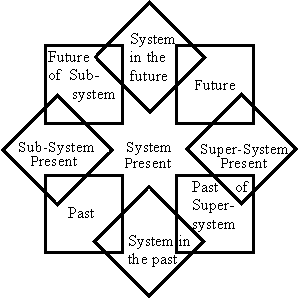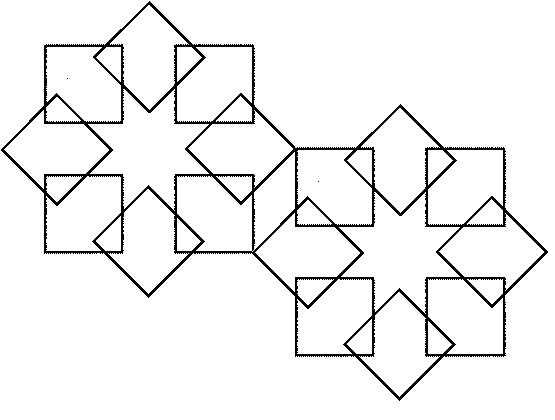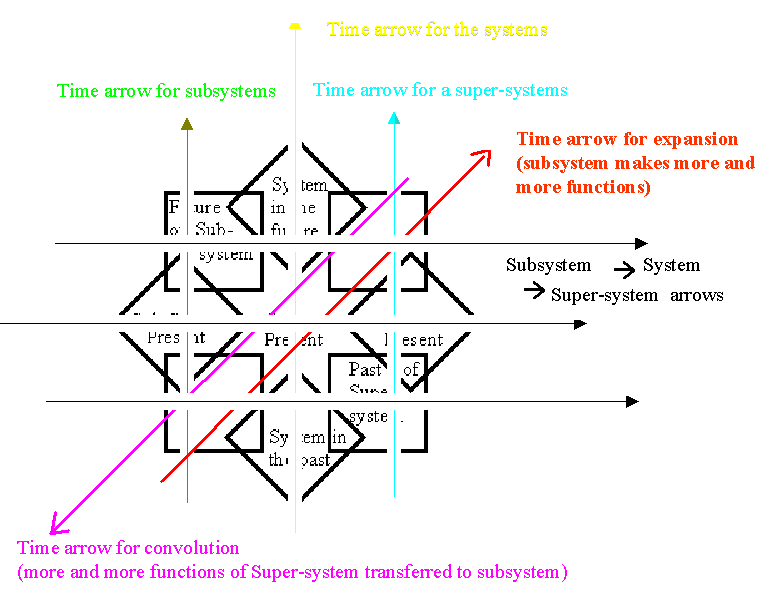May 8, 1999 and Jun. 9, 1999
with Discussion by the Editor (May 26, 1999)
|
|
|
| The System Operator | |
| Semyon
D. Savransky (The TRIZ Experts)
May 8, 1999 and Jun. 9, 1999 with Discussion by the Editor (May 26, 1999) |
Email address of the contributor: Semyon Savransky <triz_sds@hotmail.com>
| . | Dear Toru
Nakagawa,
I'd appreciate if you posted (English and Japanese) a part of a lesson from the "TRIZ Hands-on Training at the Internet" course (attached) Thank you in advance. Regards, Semyon D. Savransky, Ph.D. President The TRIZ Experts |
The System Operator
Semyon D. Savransky (The TRIZ Experts) May 8, 1999
(A small fragment (about 10%) of a lesson from "Hand-On TRIZ Training at the Internet" course).
When trying to solve a problem, we usually develop in our mind a static image of the system being improved, or an image of the system in present. However, in many instances it is much more productive to see a dynamic presentation of the system. Various problems of the present and the future can be solved and even prevented in the past.
In order to handle a dynamic picture the system operator (often called as "poly-screen approach" by TRIZniks) is very helpful.
The most common is the following
"nine-screen" approach developed. G. S. Altshuller. Imagine the display,
consisting of three lines on three screens in each. The middle horizontal
line corresponds to the technical system under consideration; the bottom
horizontal line shows subsystems, elements, forming by the technical system;
and the top horizontal line represents super-system, including researched
system as one of the elements. The left vertical line of screens reflects
the previous conditions of the system, its sub- and super-systems; the
middle vertical line shows the present condition; the right vertical line
forecasts future of the system, its sub- and super-systems. This structure
corresponds to the "nine-screen" approach ( see Figure 1).
| . |  |
|
Figure 1. The simple nine-screen model of evolving technical system |
Engineers think usually concretely but non-system: after a statement of problems an engineer often concentrates on a visual image or other representation of a particular object that should be improved. If the problem describes a tree, the person sees just a tree. In system thinking it is necessary simultaneously to imagine alongside with a tree itself (researched system) some group of trees (super-system) and separate leaves (one of subsystems); moreover, probably it is useful to include in the analysis a forest ( super-super-system of a tree), wood (another sub-system), cells in a leave (sub-sub-system), as well as left vertical line of screens (previous condition of systems), and right vertical line (future condition of systems).
In addition to the expansion of the screens upwards - in super-super-system and downwards, other screens are possible.
First, one has to see not only the system but also an anti-system (the system with opposite primary functions or properties, e.g., " to heat up - to cool ", " to mix - to divide", "be heavy - be light"), co-system ( the system with the complementary functions or properties, e.g., device for resistivity measurements and checker for type of charge carriers in semiconductor wafers production) or non-System (the system with the same primary functions or properties, e.g., both a car and a bicycle erected for transportation at ground and have same friction peculiarities ) to obtain a solution. It is possible to imagine that the screens of anti-, co- or non-system are placed on an opposite wall of a room, in which our screens for the initial system are established. A system and their anti-, co- or non-systems can have different properties (object, phenomena, process, etc.) and complexity.
Secondly, the system has an own individual history (similar to an ontogenesis, i.e., an individual development of organism from a germ up to old age) and participates in a history of group development in a super-system (similar to a phylogenesis of biological groups - from elementary virus to multi-cell organism, from ameba to animal).
For the reflection of each type of
development new screens are necessary that leads to more complicated models
that start from the "eighteen-screen" approach to complex multidimensional
polyscreen approach (see the figure 2)
 |
|
| . |
Figure 2. An element of multi-screen model of evolving technical system |
The whole multi-screen should include the following elements:
Function (primary/principal) Functions (secondary) Anti-Function
System Super-System Sub-System
Non-System Anti-System Co-System or Joint System
System in the past System in the future
Sub-System in the past
Sub-System in the future
etc.
The skill to visualize a system as hierarchical and time structures and to employ whole system family (i.e., to apply the system operator) should be developed, since it is very important for solving creative engineering problems. To make an invention, the inventor should be able
- to see a potential system in a group of separate, uncoordinated elements that represent sub-system;
- to develop certain links between the sub-systems that can create a new and useful property;
- to understand the super-system(s) of the system under consideration;
- to know limits on changes in the system and super-systems.
- to have knowledge about the anti-system, co- system and non-systems
- to be familiar with the previous developments of the system (as well as super- and sub-systems)
- to be informed about the next future
forecast of the system
The lesson include special questionnaire that is useful for training in the system approach and numerous examples.
| . | Dear Dr. Semyon
Savransky,
Thank you very much for your sending me a message and an article two weeks ago. Please forgive me for my late response. Concerning Fig. 1 of your article, I have questions: This figure does not correspond to your explanation of the "nine-screen" approach. Your screens "Future" (in the upper-right) and "Past" (in the lower-left) are misleading; probalby they should be "Future of Super-system" and "Past of Sub-system". Your axes of "time" and "system hierarchy" do not match to your explanation in their directions. In your figure, you take the "time" axis upward, while the "system hierarchy" axis horizontally to the right. Why do you think your way of arranging the nine screens better than the Altshuller's standard arrangement? Is Figure 1 an illustration of the "nine-screen" approach? or is it rather a symbol mark of your group, The TRIZ Experts? The "eighteen-screen" approach in your Fig. 2 seems not clear yet. What sort of screens do you actually need? More and more screens are not always effective; they are often too much for real applications. What is your real experience in your applying them? As the Editor of "TRIZ Home Page in Japan", I would like to make it an open forum fair and useful for the readers. In this sense, I wish you to submit it us again in a revised version. Thank you again for your interest in our "TRIZ Home Page in Japan". Best regards, Toru Nakagawa
|
Dear Toru Nakagawa,
Thank you for e-mail. Let me try to answer on your questions.
As you know the System Operator is a mental exercise with the technical system under the development. Some people fill that just a look at diamond-like structure of 8 empty squares organized like it shown at the figure 1 click on their visual imagination. Hence, such arrangement is preferable than Altshuller's picture for work against the psychological inertia. Try it with empty perfect squares !
Because such 9-screen approach works well for me, I choose it as the symbol of our The TRIZ Experts.
We specially did not say about /(sub,
super)-system/ in the upper-right and the lower-left screens. There
are two reasons:
1) any division of a technique on
subsystems is arbitrary;
2) the expansion and squeezing trends
always exist in technical evolution, so the poly-functional approach for
design has been developed in TRIZ. Just filling the screens mentioned above
with the labels PAST and FUTURE allows to have two more arrows at the simple
9-screen picture, that is very important if you want to play with the Ideality
of your system (see the attached figure)
 |
The diamond-like structure for representation of the System Operator allows also to build up as many screens as you need much easily than the rectangular-like Altshuller's picture.
The "eighteen-screen" approach is more powerful than 9-screen if you need to consider for example the system and anti-system or the transmission and engine of your system. Some TRIZniks can work even with 27-screens, but as experience shows usually imagination of engineers is limited by 18-screen (unfortunately, my too). I used to apply 18-screen approach to some problems with equipment for semiconductor industry.
If you think that the explanation above should be added to the paper - fill free to do it, but please send me English version for proof-reading.
I have read your WWW site (the English part), it is very impressive. It is very nice that TRIZ become popular in Japan, and I hope to have students from your country in our Virtual TRIZ College.
Thank you in advance.
Regards,
Semyon
| Top of this page | (1) Savransky | (2) Nakagawa's response | (3) Savransky's reply | Japanese
page |
| Home Page | New Information | Introduction to TRIZ | TRIZ References | TRIZ Links |
| TRIZ News & Activities | TRIZ Software Tools | TRIZ Papers and Tech Reports | TRIZ Forum |
Last updated on Jul. 16, 1999. Access point: Editor: nakagawa@utc.osaka-gu.ac.jp